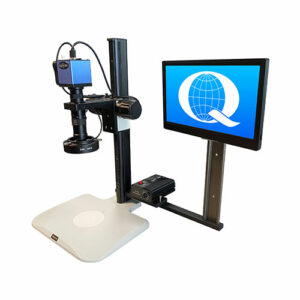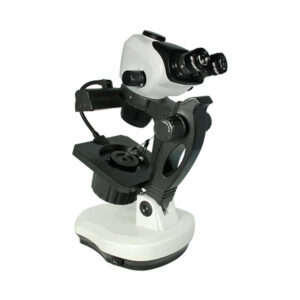About The Ergoscope ES-G100 High Eyepoint Gemology Microscope
The Ergoscope® ES-G100 High Eyepoint Gemology Microscope is a premium instrument designed for professionals in the field of gemology and jewelry inspection. This microscope offers a range of features that ensure both performance and precision.
With a Total Magnification range of 6.7-45X, the ES-G100 provides a wide range of magnification options for detailed examination of gemstones and jewelry. The Zoom Ratio of 1:6.7 allows for smooth and precise zooming, enabling users to capture fine details with ease.
The Ergoscope ES-G100 High Eyepoint Gemology Microscope is equipped with a 10X High Eyepoint Eyepiece, which ensures clear and detailed observation. The Eyepiece Field of View of Dia. 22mm provides a wide field of vision for enhanced observation, while the Binocular design with an Eye Tube Angle of 45° offers comfortable viewing for extended periods.
The microscope comes with a Jewelry Stand, which provides stability and flexibility in positioning for various applications. The stand type is specifically designed for jewelry inspection, allowing users to easily examine gemstones and jewelry from different angles.
The Ergoscope ES-G100 High Eyepoint Gemology Microscope features FH Dual Illuminated Light, which provides both top and bottom illumination for enhanced viewing. The Top Illumination is oblique, allowing for a detailed examination of gemstone facets and jewelry settings. The illumination type ensures that the gemstones and jewelry are well-lit for accurate observation.
With an Input Voltage of AC 110-220V 50/60Hz, the ES-G100 is suitable for use in a variety of environments. The microscope is designed to meet the needs of professionals in the gemology and jewelry industry, offering high-quality imaging and precise observation capabilities.
Overall, the Ergoscope® ES-G100 High Eyepoint Gemology Microscope is a top-of-the-line instrument that offers both performance and precision for professionals in the field of gemology and jewelry inspection. Its specialized design and features make it an essential tool for professionals seeking reliability and precision in their work.
Gemology/Jewelry Microscope
Gemology/jewelry microscope is a microscope used to observe some of the invisible details on the surface and inside of jewels, gems, and various crystals when observing.
The surface features of jewelry, include scratches, breakage, color circles, etches, cleavage, cracks, split faces, polish, etc.; internal features, include the types of contents, the inclusions, growth lines, double crystal lines, textures, ribbons, and the doubling of the rear facet edge of the gemstone etc. For these features, it is very necessary to use gemology/jewelry microscope for observation and identification, and it has also an extremely important application in diamond grading, making it an essential instrument for gem identification.
For general jewellery observations, the defects and features after 10X magnification are considered the basis for economic evaluation. For jewelry microscope, stereo microscope is generally used, with a magnification of 10-80X or higher, and more detailed features can be seen. According to the characteristics of jewelry observation, jewelry microscope requires large depth of field, which can present the diamonds, jewelry interiors and their polyhedral structure, with true color reproduction effect.
Due to the different types of gemstones being observed, jewelry microscope needs to be matched with a variety of light sources and illumination forms. For lighting, usually full-color light is used, its continuous spectrum reflects the true color of the jewelry, and can achieve good observation effect for transparent, translucent and opaque object. The lighting methods of gemology microscope mainly include:
Reflective illumination: use the reflector lamp above to observe opaque or translucent objects, as well as the surface features of the gem, such as the ports, cleavage surfaces, ribbons, and gemstone grinding etc.
Transmitted illumination method: the transmitted light at the bottom is used to observe the internal features and defects of the gemstone. Usually, the bottom light is a diffuse reflection light source with dark field illumination, and there is a switch button, in the center of the bottom light, there is a black disc “light block”, used to switch the light and dark field of view conversion of the bottom light.
Transmitted bright field illumination: the transmitted light can penetrate the interior of a gemstone. Against a bright background, details within the jewelry such as inclusions, textures, growth lines and ribbons can be seen clearly.
Transmitted light field dark illumination: after the bottom light is blocked by the “light block”, it cannot directly enter the field of view of the objective lens, forming a diffuse reflection illuminating the gem around it, which is convenient for observing the inclusions, cracks and growth lines of the gemstone, and seeing the details that are not easy to find in bright field.
Spot light illumination method: adjust the aperture diaphragm (aperture) to a position close to the smallest suitable size, so that the bottom light is reduced into a dot shape, and the light penetrates from the bottom of the gemstone for illumination, so that the ribbon and the structural feature points of the gemstone are more prominent.
Horizontal illumination method: use a sidelight to illuminate the gemstone horizontally from the side, so that the gem dot-like inclusions, textures, and bubbles etc. present striking and bright image under the vertical direction light illumination.
Masking illumination method: use the bottom light bright field for illumination, insert an opaque light barrier in the field of view to increase the three-dimensional sense of the internal feature points in the black and white boundary of the light, which helps to observe the growth structure of the gem, such as the bending growth lines, double crystal lines, etc.
Scattering illumination method: use the bottom light bright field for illumination, place a tissue or other translucent material on the light source to make the light softer, which helps to observe the color gamut and the ribbon, especially to observe the diffusion treatment effect of the gemstone.
Polarized illumination method: under the bottom light source and the objective lens, a polarizer piece is added respectively to produce a polarizing effect, which can help to observe the interference effect, pleochroism and the optical characteristics of the gemstone.
For more precautions for use of gemology/jewelry microscopes, please refer to the Stereo Microscope on the Quality Control Solutions, Inc. website.








 Scroll to Top
Scroll to Top